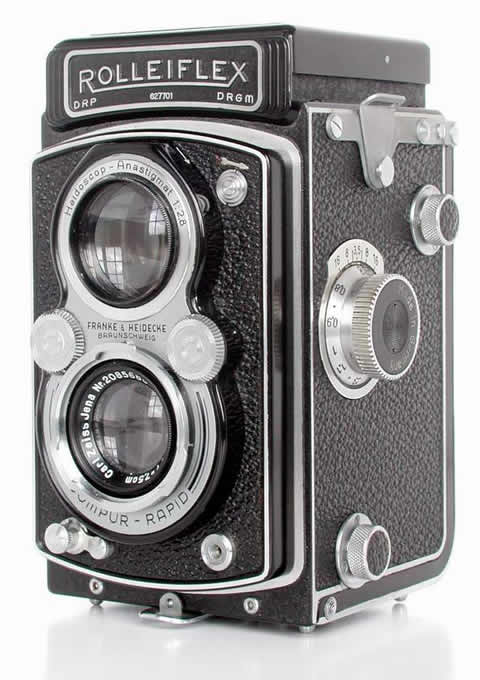

As far as I know, this model is not compatible with the Rollei prism finder, though I never felt the need for one on a TLR. The waist-level finder (WLF) is used for focusing and it snaps into focus nicely.
#ROLLEIFLEX 2.8 ROLLEIKIN FLICKR FREE#
The Rolleiflex 2.8C does not have an EVS system and I consider this an advantage because you need not worry about those dials moving together and you’re free to choose whatever aperture/shutter speed combo you like. Right near the lenses, the aperture control dial will be on your left hand side and the shutter speed control dial on your right hand side. The shutter automatically cocks when you turn the winding crank and pull it back. The focus knob is on your left side and the film wind crank is on your right side when the camera is in use.

#ROLLEIFLEX 2.8 ROLLEIKIN FLICKR PRO#
It will probably be heavier than a mirrorless with lens, but would weigh less than your mid-level or pro Canon/Nikon body with pro lens. The Rolleiflex 2.8C is well built, as are all the top tier Rolleiflexes. Can’t remember the film though it’s most likely Tri-X or Neopan. Keep in mind that the Rollei has a mechanical shutter and that is always going to be less accurate than an electronically timed shutter, so if you feel the speeds are way off, get a CLA. It has never had a CLA, though I think a CLA is long overdue. I got it used, in bargain condition in 2008. It’s got a great lens and doesn’t need batteries to operate. You will be fine with any of the Rolleiflex 2.8 series, A/B/C/D/E/F…you have lots of choices!īack to the Rolleiflex 2.8C…Why do I love it? Simple, it always delivers the goods. This article focuses on the 2.8C model specifically. I could try and explain it, but it will be nowhere as helpful as actually handling a TLR. With that said, if you are new to TLR photography then I suggest you go and try one out. As always I encourage my readers to do more research if they’re really interested. In fact, I’ve decided that I have much more fun giving you a “review” through my impressions and experiences rather than writing a long, formal review. I do try to give you everything I think you might need to know, but I might miss a thing or two.

The camera is over sixty years old and I think there are already some fine reviews out there. I am just an enthusiast who loves Rolleis and Rolleiflexes and have enjoyed using and collecting Rollei items over the years and doing so “under the radar” (until now I guess!) like I’m sure many of you out there. I do not consider myself one of those experts. It might matter for camera historians, but for shooters either lens I think would be plenty fine regardless of which one came first on the 2.8C model.īefore I go further, I should say that Rolleiflexes have a large and passionate following around the world with many, many Rollei experts out there. I really don’t know and at this point, does it really matter?

I’ve read different accounts that the Planar was offered first and the Xenotar was just a “replacement” lens that were used when production of the Planar was in short supply. Keep in mind that “early” and “late” for this camera was only from 1952-1955. The latter version known as Type II offered either the Planar or Xenotar. The Rolleiflex is always ready to shoot…and it’s going to drive you insane man! 🙂Īs far as I can tell, the very early versions are known as Type I and only offered the Xenotar lens. Introduced around 1952-1953, it was the first Rolleiflex model to feature either the Zeiss Planar or Schneider-Kreuznach Xenotar f/2.8 lenses. If I could only have one camera, it would probably have to be my venerable Rolleiflex 2.8C with the Schneider Xenotar lens. However, if the folks running Rollei now can return it to its glory, I’ll be the happiest guy here! Thanks for the information! I’m glad to know this, although I do stand by my statement of the Rollei “as we know it” being gone. UPDATE: One of our readers kindly pointed out that “Rollei” still makes digital medium format cameras. Today we look at one of their many standout models, the Rolleiflex 2.8C twin lens reflex camera. Rollei made many, many great and iconic cameras, but their TLR cameras are where they made their name. The camera produces 6×6 square format images on 120 film.Īlthough the last remnants of Rollei as we know it vanished completely in 2015, it was and is considered one of the greatest names in photography. The Rolleiflex 2.8C is a medium format, twin lens reflex camera introduced in 1952 by Franke & Heidecke, aka Rollei GmbH of Germany.


 0 kommentar(er)
0 kommentar(er)
